EAS439 Tutor-Marked Assignment: Numerical Analysis January 2025 Presentation
| University | Singapore University of Social Science (SUSS) |
| Subject | Numerical Analysis |
TUTOR-MARKED ASSIGNMENT (TMA)
This assignment is worth 12% of the final mark for EAS439 Numerical Analysis.
The cut-off date for this assignment is 23 March 2025, 2200hrs.
Note to Students:
1. Submit your solution document in the form of a single MS Word or PDF file before the submission cut-off date shown above in the CANVAS system.
2. Late submission will be subjected to the mark deduction scheme. Please refer to the Student Handbook for details.
3. Indicate your full name, student ID number and SUSS email address on the cover page of your report.
4. Name the file in the format: “EAS439_TMA_YourFullName_YourStudentID”.
5. Save your report in PDF format, leaving a 2.54-cm margin on all sides of an A4-sized document.
WARNING ON PLAGIARISM AND COLLUSION
Plagiarism and collusion are forms of cheating and are not acceptable in any form of a student’s work, including this assignment. You can avoid plagiarism by giving appropriate references when you use some other people’s ideas, words or pictures (including diagrams). Refer to the American Psychological Association (APA) Manual if you need reminding about quoting and referencing.
You can avoid collusion by ensuring that your submission is based on your own individual effort. The electronic submission of your assignment will be screened through a plagiarism detecting software, Turnitin. For more information about plagiarism and cheating, you should refer to the Student
Handbook. SUSS takes a tough stance against plagiarism and collusion. Serious cases will normally result in the student being referred to SUSS’s Student Disciplinary Group. For other cases, significant marking penalties or expulsion from the course will be imposed.
Question 1
Figure Q1 shows the forces acting on an aircraft at level flight.
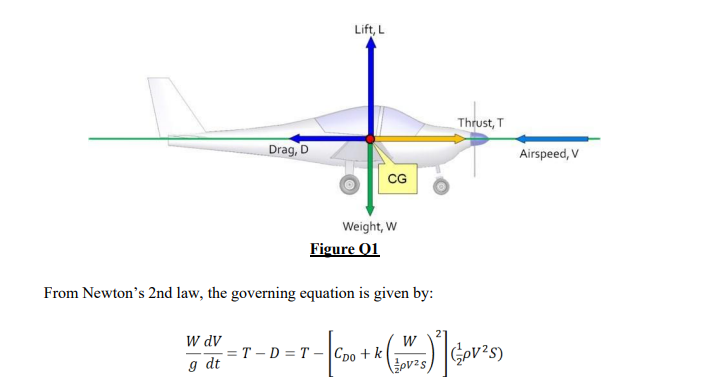
where and are the parameters for the aircraft aerodynamic drag polar, is the wing area, and is the air density.
(a) Formulate numerical approximations to the equation using forward difference to compute the aircraft speed V, for the level flight to accelerate speed from V1 to V2 . (8 marks)
(b) An aircraft has the following characteristics:
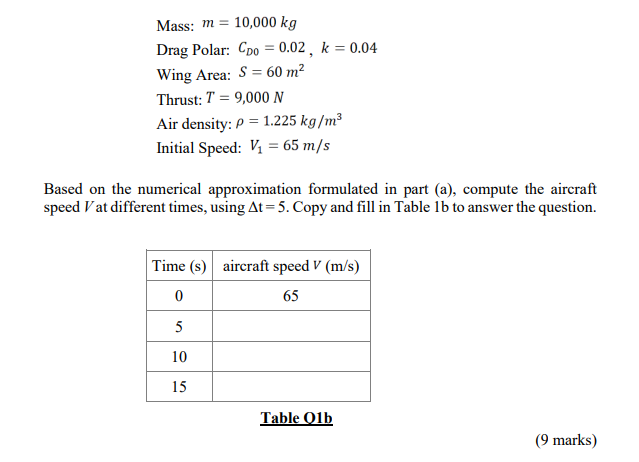
(c) Analyse the accuracy and efficiency of the numerical formulation used, by commenting the effect of Δt on the result accuracy and the algorithm efficiency. (3 marks)
(d) Explain the difference between “Total Error” and “Approximation Error”, and their respective usage. (5 marks)
Hire a Professional Essay & Assignment Writer for completing your Academic Assessments
Question 2
(a) Given the following system of equations:

Calculate the solution using the Gauss-Jordan elimination method. Show all steps of the computation. (10 marks)
(b) The deflection of a cantilever beam under the uniformly distributed load is given as follows:

where y is the vertical deflection, E is the modulus of elasticity, I is the area moment of inertia, and L is the length of the beam. The cantilever beam is fixed at root x = 0 and the free end is at x = L. Use Simpson’s 3/8 rule to design and implement a computational step to calculate the deflection of the beam at x = L.
Question 3
The measured data for the drag coefficient Cd of a symmetric NACA-0015 airfoil at different angles of attack α is given in Table Q3 below.
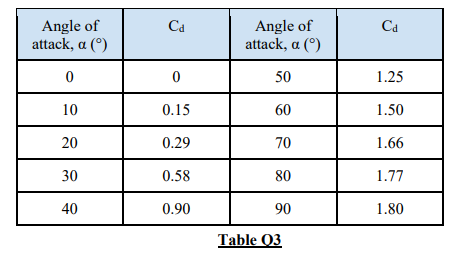
Buy Custom Answer of This Assessment & Raise Your Grades
Question 4
An aluminum rod that is insulated at all points except at its ends experiences heat conduction along its length as illustrated in Figure Q4 below.
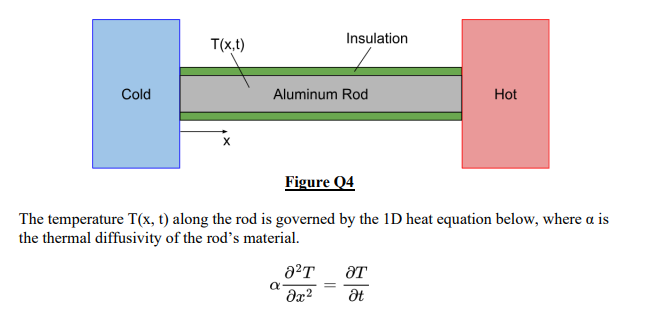 (a) Formulate the numerical solution of the heat equation using the explicit method. (3 marks)
(a) Formulate the numerical solution of the heat equation using the explicit method. (3 marks)
(b) By discretizing the rod into 6 equal segments and using a time step of 60 seconds, calculate the approximate solutions of T(x, t) in °C (round off to 1 decimal place). Copy and fill in Table Q4b to answer the question. The initial temperature of the rod is 45°C and the left and right ends are maintained at 25°C and 230°C respectively.
The properties of the aluminum rod are given below.

(c) By direct integration, solve for the exact steady-state temperature T(x) of the aluminum rod. Hence, appraise your numerical solution in part (b) at t = 30 hrs and analyse its accuracy. (7 marks)
(d) The left end (x = 0) of the aluminum rod is now thermally insulated and no longer subjected to a fixed temperature. In addition to the numerical solution in part (a), formulate the extra condition/s needed to simulate the temperature of the rod subjected to an insulated left end. (5 marks)
(e) For the aluminum rod with its left end thermally insulated, calculate the approximate solutions of T(x, t) in °C (round off to 1 decimal place). Copy and fill in Table Q4e to answer the question. Use all other conditions given in part (b) except for the rod’s left end temperature.
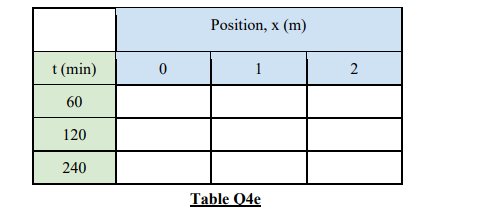
Stuck with a lot of homework assignments and feeling stressed ? Take professional academic assistance & Get 100% Plagiarism free papers
- CH2123 Assignment: Fugacity, VLE Modeling & Applications of Henry’s Law
- BAFI1045 Assignment -Constructing and Evaluating Passive and Active Portfolios Based on the Straits Times Index (STI)
- FIN2210E/FIN2212E Group Assignment: Financial Risk Management Analysis of Bursa Malaysia Companies
- FLM101 Assignment: A Film Analysis: Stylistic Techniques and Their Thematic Importance
- HRM Assignment Answer: Talent Transformation in the Age of AI: Turning Challenges into Opportunities via Ecosystem Innovation
- COMP 1105 Assignment: Health-Focused E-Commerce Website: A Web Technologies Project Using HTML5, CSS, and JavaScript
- Assignment Anwser: Machine Learning in Robo-Advisory Services: Evolution, Applications, and Future Trends
- OMGT2229 Assignment: Quantitative EOQ Analysis, and Strategic Sourcing Decisions for JB Hi-Fi
- Assignment 2 Anwser: Corporate Finance and Planning: An In-Depth Financial Analysis of Company
- BUSM4551 Assignment: The Role of Innovation in Advancing the UN Sustainable Development Goals (SDGs)
UP TO 15 % DISCOUNT


